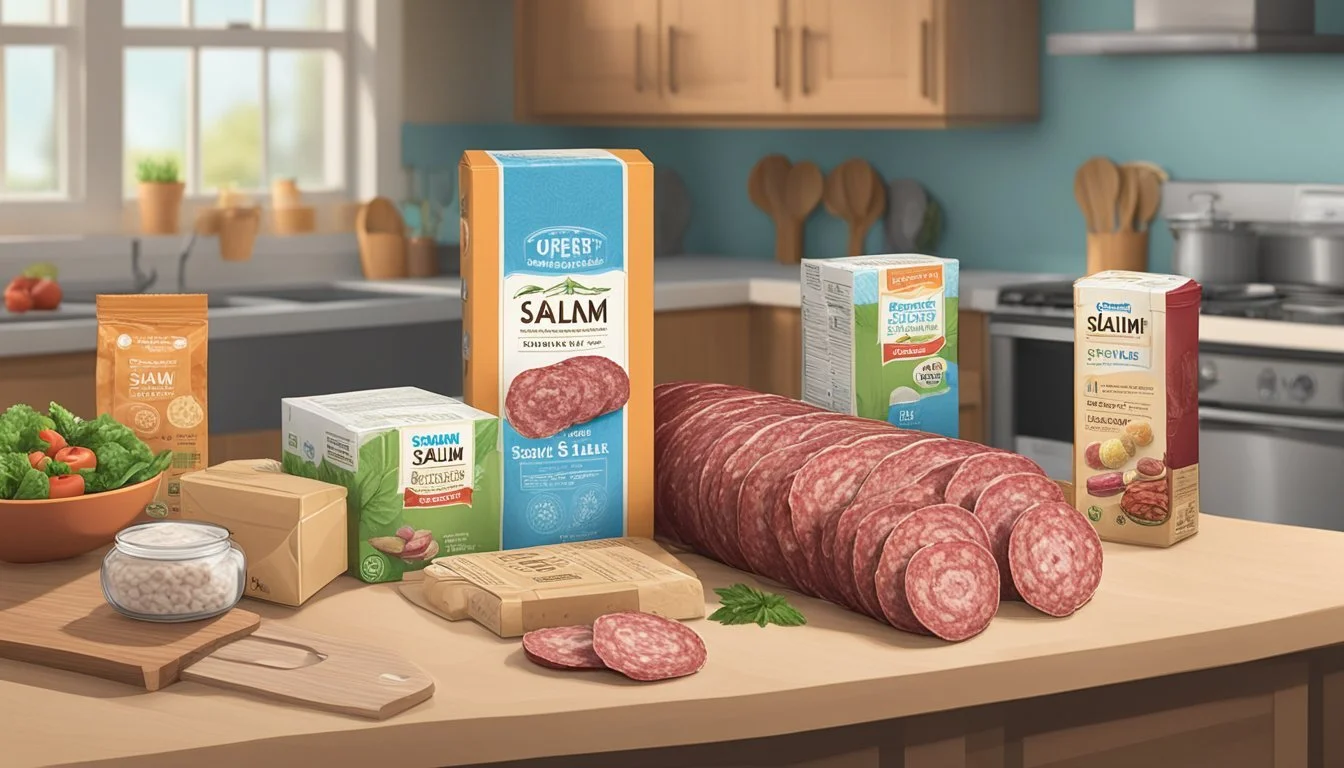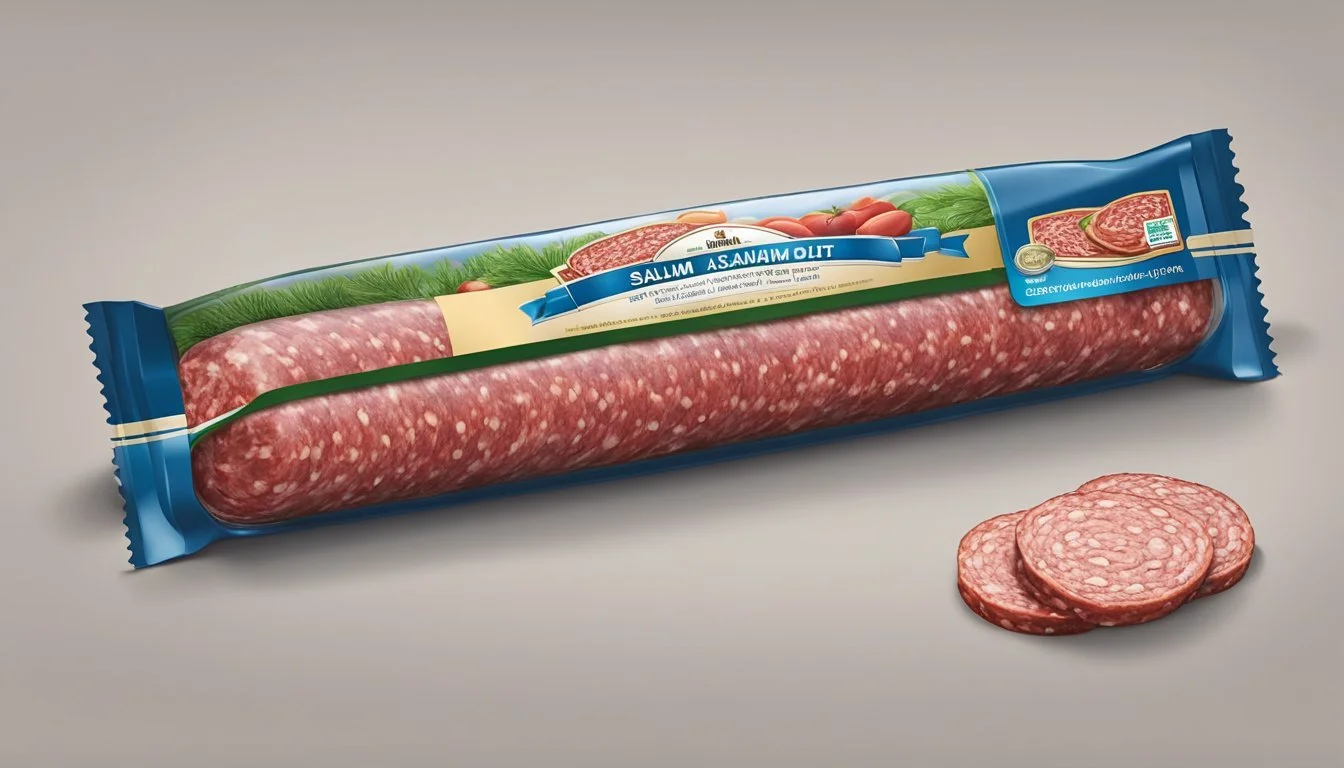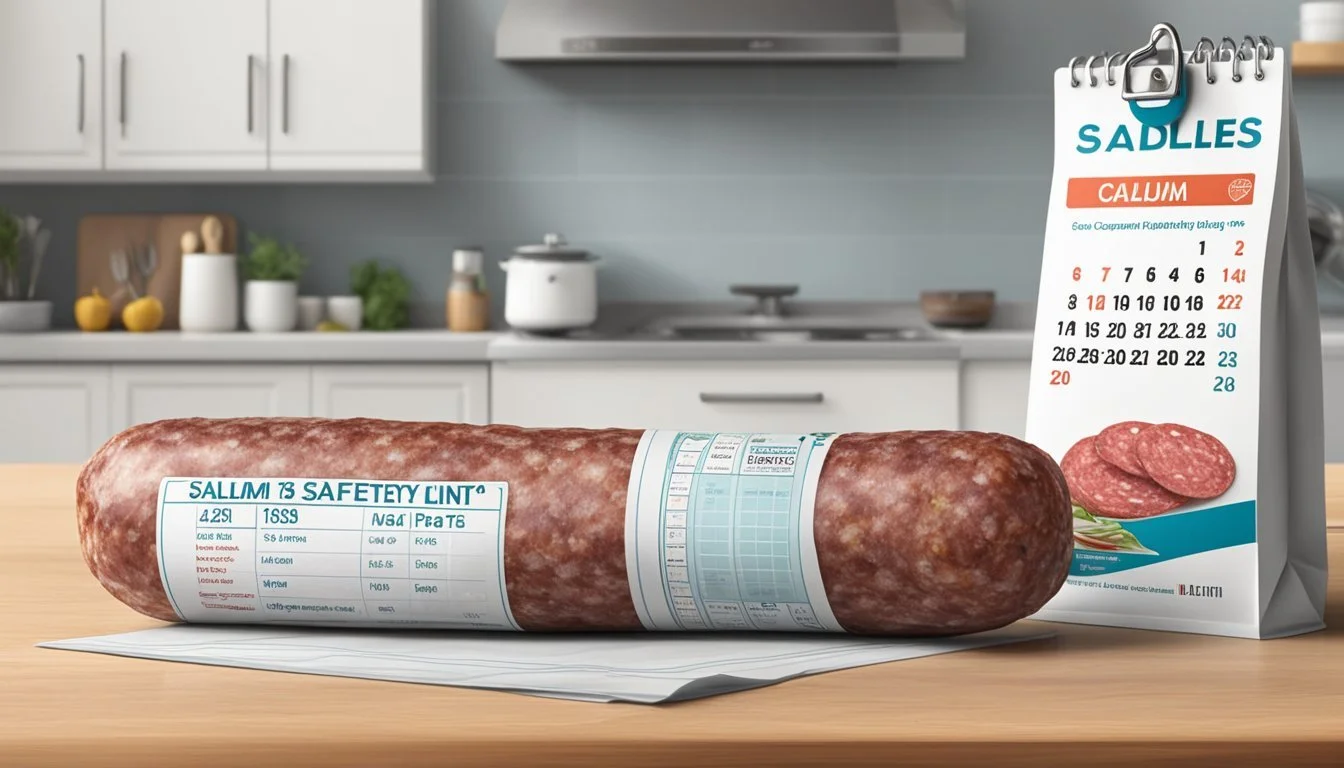How Long Does Salami Last?
Understanding Shelf Life and Storage Tips
Salami, a popular cured meat with a variety of flavors and textures, is a staple in cuisines worldwide. Its shelf life varies based on several factors, including the type of salami, whether it's been opened, and the storage conditions. Typically, unopened dry or hard salami can be kept at room temperature for up to six weeks if stored in a cool, well-ventilated area. When refrigerated, unopened salami may last indefinitely, as the curing process extends its longevity by inhibiting bacterial growth.
Once salami is opened, however, the clock starts ticking on its freshness. It's essential to store sliced salami in the refrigerator, where it remains safe to consume for about three weeks. Fresh salami types, which contain more moisture than their dry counterparts, are more perishable and generally last five to seven days in the fridge. Observing proper food safety by paying attention to the product's best-by date, and noting changes in color, texture, or smell, can help determine if the salami is still suitable for consumption.
Factors Affecting Salami Shelf Life
The longevity of salami is influenced by its composition, the curing process, and how it is packaged. Understanding these factors is crucial to maximizing shelf life and ensuring safety and quality.
Composition and Quality of Salami
The composition of salami, including the type of meat and fat ratio, impacts its shelf life. High-quality ingredients tend to result in a product that lasts longer. Additionally, the inclusion of preservatives can also extend the shelf life. Salami with a higher fat content may spoil more quickly than leaner varieties.
Preparation and Curing Process
The curing and drying processes are critical in determining the shelf life of salami. Curing involves using salt and other preservatives to inhibit bacterial growth. A longer curing process can contribute to a salami that is more resilient and has an extended shelf life. Proper drying removes moisture that could otherwise allow for the growth of mold or bacteria.
Packaging and Oxygen Exposure
The way salami is packaged influences its exposure to oxygen. Salami is best preserved when stored in an airtight container or vacuum-sealed packaging to reduce oxygen exposure which slows down the oxidation process. If salami is not packaged properly, with exposure to air, it can spoil much faster. For example, both plastic wrap and aluminum foil are common materials for keeping salami in an oxygen-reduced environment, thus extending its shelf life.
Types of Salami and Their Longevity
The shelf life of salami varies greatly depending on its type and whether it's fresh, dry, cooked, or cured. Each type has unique storage needs and longevity.
Dry vs Fresh Salami
Dry salami, also known as hard salami, is a cured meat with a firm texture and tangy flavor. It typically lasts much longer than fresh salami because of its low moisture content, retaining quality for up to six months in the refrigerator. It can also be stored in the pantry for up to six weeks.
Fresh salami, on the other hand, has a higher moisture content and requires refrigeration. It should be consumed relatively quickly, usually within three to five days of opening, to maintain its quality and safety.
Whole vs Sliced Salami
Whole salami provides a longer shelf life due to its intact casing, which protects the meat from contamination and moisture loss. When stored properly in a cool, dry place or in the refrigerator, whole salami can last for weeks or months depending on whether it is dry or fresh.
Sliced salami, once the casing is breached, becomes more susceptible to spoiling. When refrigerated, sliced salami should be consumed within three weeks. Freezing can extend this lifeline up to two months, but it is essential to wrap it in a freezer bag or aluminum foil before freezing.
Cooked vs Cured Salami
Cooked salami is typically ready to eat and has a shorter lifespan than cured salami because the cooking process does not remove as much moisture. Refrigeration is necessary, and it is best consumed within two weeks of opening to ensure safety and freshness.
Cured salami, a type of dry salami, benefits from a preservation process involving salt and air drying which extends longevity. Cured varieties can be edible for many months when stored properly in the fridge or a cool, dry environment.
Optimal Storage Conditions
To maintain the quality and extend the shelf life of salami, proper storage is critical. Specific conditions prevent spoilage and preserve the characteristics of the meat.
Refrigeration Methods
Storing salami in the refrigerator is essential once it has been opened. It should be wrapped tightly to protect it from air and moisture – the primary culprits of spoilage. For best results:
Wrap the cut end of salami in plastic wrap: This keeps out moisture and air.
Refrigerate at consistent temperatures: A steady temperature between 34°F and 40°F (1°C to 4°C) is ideal.
Cool, Dry Places for Storage
An unopened salami benefits from being kept in a cool, dry place. The ideal storage condition for such salami includes:
Well-ventilated space: Air circulation prevents moisture buildup.
Room temperature: Cooler room temperatures are preferable, but avoid direct sunlight and heat sources.
Freezing Salami for Extended Shelf Life
For long-term conservation, freezing salami is effective. To properly freeze salami:
Wrap salami in aluminum foil or a freezer bag: This offers protection from freezer burn.
Thaw in the refrigerator: Gradual defrosting maintains quality and texture.
Recognizing Spoiled Salami
When determining if salami has spoiled, one should examine visual cues and assess the texture and odor. These indicators help to identify if the product has become unsafe or undesirable to consume.
Visual Signs of Spoilage
Discoloration: Salami exhibiting green, black, or gray spots may indicate the presence of mold. Such discoloration is a clear sign that the meat is no longer consumable.
Mold Growth: If one observes white film or black fuzz, it's critical to discard the salami, as these are signs of mold, which can harbor harmful bacteria.
Texture and Odor Indicators
Texture: A slimy or overly wet surface is a tell-tale sign of bad salami. When spoiled, salami may feel sticky or tacky, rather than the usual dry and firm texture.
Odor: Salami should have a distinct, slightly spiced aroma, not an off or rancid smell. An unpleasant or sour odor often indicates spoilage and potential bacterial growth.
Health Safety and Consumption Guidelines
When it comes to salami, understanding the balance between proper handling and the risks of food poisoning is crucial for safe consumption.
Food Poisoning Symptoms
Food poisoning occurs when one ingests harmful bacteria or toxins, which can be present in improperly stored or spoiled salami. The symptoms include:
Nausea: A disturbing sense of unease and discomfort in the stomach signifying the onset of food poisoning.
Vomiting: The body's way of expelling contaminated substances.
Diarrhea: Frequent loose or watery stools that indicate digestive distress.
It is essential to monitor these symptoms and seek medical attention if they persist or worsen.
Proper Handling and Cooking
Salami, a cured meat, requires careful handling and sometimes cooking, to ensure safety. Here's a concise guide:
Unopened Salami:
Can be stored at room temperature in a cool, dry, and well-ventilated area.
Has a longer shelf life when refrigerated: up to 6 weeks in the fridge and up to 6 months in the freezer.
Opened Salami:
Should be consumed within 3 weeks when stored in the refrigerator.
Requires wrapping the cut end in plastic wrap or aluminum foil to avoid exposure to air.
Must be thawed in the fridge if it has been frozen to ensure even and safe temperature transition.
Cooking Salami: Though most salami is ready to eat, cooking increases its safety, particularly if the product is past its prime consumption period.
Individuals must always follow the manufacturer’s instructions and expiration dates to minimize risks of contamination. Keeping salami out of the danger temperature zone (40°F - 140°F), where bacteria rapidly grow, also aids in preventing foodborne illnesses.
Salami Lifespan Post-Opening
Once salami is opened, the shelf life is significantly reduced due to oxidation and exposure to air, which can affect its quality and safety. Opened salami should be handled with care to maximize its lifespan and maintain its freshness.
Storage Method:
Refrigeration: It is essential to refrigerate opened salami. Doing so slows down the oxidation process and preserves the salami's integrity. Ideally, one should wrap the cut end with plastic wrap or store it in an airtight container to minimize exposure to air.
Lifespan Estimates:
In the Fridge: An opened salami typically lasts for up to three weeks in the refrigerator. This time frame can vary depending on the salami's initial freshness and how well it is wrapped.
Freezing Option: For extending its usability beyond the typical refrigerated period, salami can be frozen. To freeze, one should wrap the salami in aluminum foil or place it in a freezer bag before putting it in the freezer.
Indicators of Spoilage:
Smell: Trusting one's nose is a good practice. A sour or unpleasant odor is a key indicator that the salami may have spoiled.
Visual Inspection: Any discoloration, sliminess, or visible mold growth on the salami suggests it should no longer be consumed.
Expiration Awareness: While salami does not spoil as quickly as some other deli meats, consumers should always check the product's sell-by or use-by date as a guideline, keeping in mind that these dates relate to the product's unopened shelf life. Once opened, the countdown to spoilage accelerates.
Expiration Dates and Food Waste
Expiration dates on food products like salami are often misunderstood, leading to unnecessary waste. Proper interpretation and preservation techniques can help minimize this.
Understanding Use-By and Expiration Dates
Expiration dates indicate the last day that a product is guaranteed to maintain its quality and safety, though many products remain consumable beyond this point. Salami, a cured meat, typically features a use-by or best-before date, a manufacturer's estimate of when peak quality begins to decline. However, salami often remains safe to eat well after this date if stored correctly. It's crucial to distinguish between these dates to reduce food waste effectively:
Use-By: Relates more to safety and is the last date recommended for the consumption of the product.
Best-Before: Suggests when the product may start to deteriorate in quality but usually remains safe to consume.
Minimizing Waste Through Preservation
Preservation techniques can extend the life of foods like salami beyond their suggested expiration dates. Refrigeration is key once salami is opened, as indicated by the following guidelines:
Unopened Salami: Store at room temperature in a cool, dry, and well-ventilated space.
Opened Salami: Wrap the cut end with plastic wrap and refrigerate immediately.
Freezing offers a long-term solution:
Wrap salami tightly in aluminum foil or a freezer bag.
Label with the freeze date.
Thaw in the refrigerator overnight when ready to eat.
Adhering to these methods helps maintain salami's safety and quality, thereby reducing waste linked to prematurely discarded food.
Creative Uses for Salami Before It Spoils
Salami, with its rich flavors, can provide a delicious twist to many dishes and platters. Here are focused ways to use salami creatively before its shelf life is up.
Recipes and Cooking Ideas
Salami and Cheese Stuffed Bread: A savory loaf packed with slices of salami, mozzarella, and a sprinkle of herbs.
Salami Carbonara: A classic pasta dish with a salami update, swapping out traditional pancetta.
Hearty Salami Omelet: A protein-rich breakfast featuring eggs and salami, perfect for a fulfilling start to the day.
Incorporating Salami in Charcuterie Boards
Pair thinly sliced salami with assorted cheeses; the umami from the salami complements creamy and sharp cheeses alike.
Offer sliced pepperoni alongside salami for variety in spice and flavor on your charcuterie board.
Add contrast with pickled vegetables and fresh fruits to balance the richness of the salami.
Include different types of bread, such as artisan crackers or sliced baguette, to accompany the salami.
Frequently Asked Questions
In addressing common queries about salami, it is essential for consumers to understand the intricacies of its shelf life, proper storage techniques, and the distinctions that different types of salami present.
Can You Eat Salami Past Its Expiration Date?
Expiration date: Salami should ideally be consumed by the expiration date provided by the manufacturer. Although dry-cured salami may last beyond this date if stored properly, one should inspect the salami for changes in texture, smell, and color, and exercise caution, as consuming past the expiration can pose a health risk.
How to Store Salami After Opening?
Storage: Once opened, it's vital to store salami correctly to maintain its quality and safety. Wrap the cut end with plastic wrap or butcher paper, and refrigerate it. For sliced salami:
In the fridge: Consume within 1 to 2 weeks.
In the freezer: Lasts up to 6 months; thaw in the fridge overnight.
Difference Between Dry Salami and Other Deli Meats?
Dry salami vs. deli meat: Dry-cured salami is distinguished from most deli meats by its curing process and longevity. Dry salami does not require refrigeration before opening due to the curing and can last for several months uncut at room temperature in a cool, well-ventilated space. Once opened, storing in the refrigerator is necessary, as with other deli meats.
Conclusion
Salami's shelf life varies significantly depending on whether it is cured or uncured and how it is stored. Proper storage methods are crucial to extend the shelf life and maintain the quality of salami.
Uncured Salami:
Refrigerator: Up to 6 weeks.
Freezer: Up to 6 months (when properly wrapped).
Cured Salami:
Room temperature: Can last for several weeks in cool, well-ventilated conditions if unopened.
Refrigerator: Lasts for 3-7 days once opened.
Consumers should look for changes in texture, smell, and color as indicators of spoilage. Salami does not have a set expiration date due to its curing process, but quality diminishes over time.
It is advised to wrap the salami tightly in plastic wrap or butcher paper and refrigerate after opening. For unopened salami, a cool, well-ventilated space at room temperature helps maintain freshness. Freezing salami is an option for long-term storage; thaw it in the refrigerator to prevent bacterial growth.
Remember that these guidelines are generalized estimates, and the specific shelf life may vary based on the product type, preservation methods, and conditions of storage. Always exercise caution and common sense, discarding any meat that shows signs of spoilage.











